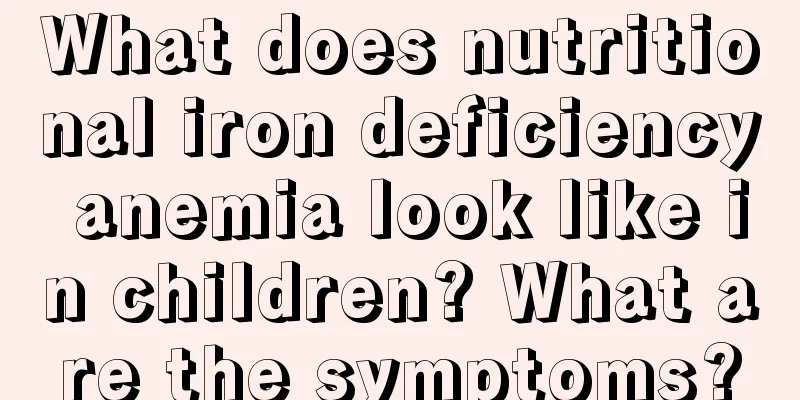What does nutritional iron deficiency anemia look like in children? What are the symptoms?

|
Nutritional iron deficiency anemia is the most common type of anemia in children. Long-term anemia in infancy and childhood will affect their lifelong intellectual development. Therefore, we must not only understand its symptoms, but also know how to prevent it in order to prevent it from happening. For infants and young children, even mild anemia may impair their intellectual development. So what should we do? Below, the editor introduces some preventive measures. Nutritional iron deficiency anemia is the most common disease in infants and young children aged 6 months to 2 years. The iron stored in the baby's body can only meet the needs of growth and development within 4 months. However, babies aged 4-6 months old gain weight and height rapidly, and their demand for iron is also high. Therefore, iron deficiency anemia is prone to occur. Symptoms of nutritional iron deficiency anemia: Most symptoms and signs of mild anemia are not obvious. By the time obvious symptoms appear, it is usually moderate anemia, which is mainly manifested by pale upper lip, oral mucosa and nails; mild enlargement of the liver, spleen and lymph nodes; loss of appetite, irritability, inattention and intellectual impairment; and obvious anemia with increased heart rate, enlarged heart, and often complicated by infection. Laboratory tests showed that the red blood cells in the blood became smaller, the hemoglobin decreased, and the serum ferritin decreased. Specific preventive measures for nutritional iron deficiency anemia: 1. Adhere to breastfeeding. The iron content of breast milk is the same as that of cow's milk, but its absorption rate is high, up to 50%, while cow's milk is only 10%. Breastfed infants are less likely to suffer from iron deficiency anemia than those who are bottle-fed. 2. Add iron-rich complementary foods in time (such as egg yolks, fish paste, liver paste, minced meat, animal blood, etc.). 3. Add green vegetables, fruits and other foods rich in vitamin C in time to promote iron absorption. 4. When choosing complementary foods, you should choose iron-fortified foods. 5. Check hemoglobin regularly, once at 6 or 9 months of age, and every six months thereafter. Detect anemia in a timely manner. The editor recommends that parents who have children with mild nutritional iron deficiency anemia should mainly rely on diet therapy, supplemented by drug therapy. Babies with anemia should be breastfed whenever possible. Develop good eating habits, eat a wide range of foods, prevent picky eating, and do not give children tea to prevent affecting iron absorption. |
<<: What should I do if my baby cries while swimming?
>>: What exactly is going on with thrombocytopenia in children?
Recommend
What is the treatment for sinusitis in children?
Children are also susceptible to rhinitis, so if ...
How to prevent baby indigestion
In weather like summer, the body is easily invade...
What is the treatment for umbilical hernia in children?
Some children are found to have umbilical hernia ...
Children vomiting in the middle of the night with a sour smell
We all know that children's stomachs are rela...
What to do if your child has a severe cough
Children's cough is a common disease that occ...
Can astigmatism in children be cured? How to treat it?
Astigmatism is not unfamiliar to many people, and...
Solutions for cold hands and feet in children
Because children are too young and have not yet f...
What causes dark circles under boys' eyes?
Nowadays, more and more people have dark circles ...
What foods cause precocious puberty?
In our daily life, there are many foods that may ...
Why can’t children urinate completely? These factors need to be taken into account
Parents, please take note: if your child has trou...
What causes a child to cough and have phlegm at night?
Children's immunity is relatively low, and th...
Yellow discharge in newborn baby
After the baby is born, mothers pay attention to ...
How long does a child’s fever due to indigestion usually last?
Many babies will have fever symptoms when they ha...
Pediatric chest compression techniques
We know that when someone drowns or has respirato...
Can a child with a short neck grow taller?
When parents are taking care of their children, t...









